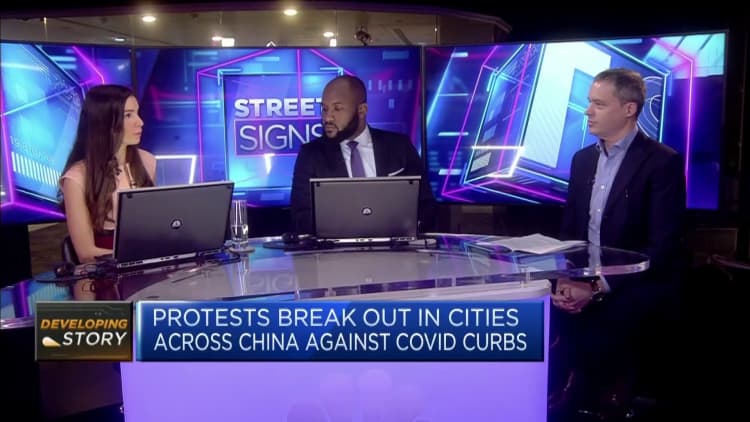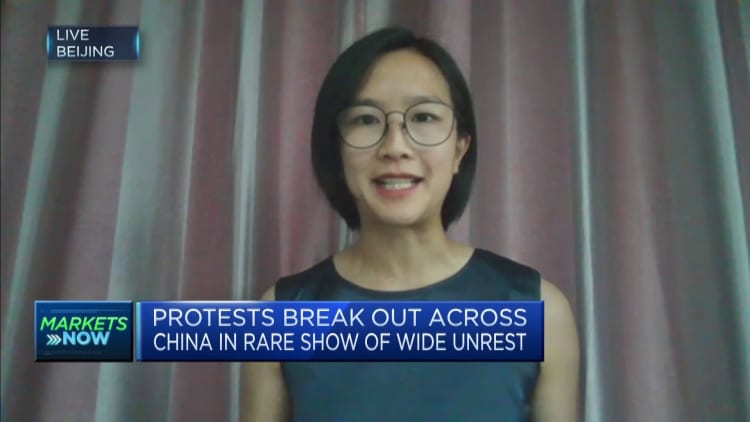China protests send global stocks lower as strategists see Covid disruption persisting
Traders work on the floor of the New York Stock Exchange (NYSE) in New York, US, on Wednesday, Nov. 9, 2022.
Michael Nagle | Bloomberg | Getty Images
Global stocks pulled back on Monday after rare protests erupted across China over the weekend amid growing unrest over the country’s zero-Covid policy.
An apparent easing earlier this month had fueled hopes of a gradual easing of the country’s strict Covid controls. However, local lockdowns in recent days in response to surging infections have seen fears resurface over both the domestic economic recovery and global supply chains.
Shares in Asia-Pacific retreated on Monday, with Hong Kong’s Hang Seng index shedding 1.6% to lead losses, while the pan-European Stoxx 600 dropped 0.9% during morning trade in Europe. U.S. stock futures also pointed to a lower open on Wall Street Monday.
Almost three years of lockdown measures have dragged down the Chinese economy and pushed youth unemployment to nearly 20%. Meanwhile, profits at China’s industrial companies fell 3% from January to October as Covid curbs stymied activity.

Strategists at Citi said the restrictions in relatively less affected cities like Shenzhen and Shanghai highlighted the difficulty China faces in moving toward reopening.
“The path to re-opening is likely to be noisy with local infections at risk of remaining high in winter months and until vaccination rates rise more meaningfully,” Citi strategists said in a note Monday.
“While the setback to sentiment from protests in mainland and tightening of Covid restrictions in several cities are unlikely to bode well for sentiment, we are cautious not to interpret these as overly bearish.”
‘Covid coma’
Though the protests have grown in recent days, coverage of them has been limited in China and the risks associated with another large-scale outbreak are heightened by an aging population and low take-up of vaccines.
As such, Rory Green, head of China and Asia research at TS Lombard, said that the government is unlikely to change course owing to this “health care reality,” and said that despite the prospect of more targeted and optimized lockdowns, the “upshot for the economy is bleak.”
“We think China stays in this Covid coma until at least Q2 2023 and real growth — not that reported by officials — is going to struggle to top 1% over the next five months,” he told CNBC Monday.
The government has been ramping up efforts to support the economy, including its embattled property sector. The People’s Bank of China said last week that it would cut the reserve requirement ratio for banks by 25 basis points from Dec. 5., freeing up around $70 billion to underpin the country’s slowing economy.

However, Green argued that the hit from lockdowns, particularly to consumer confidence, service sector jobs and wage growth, was so substantial that the PBOC’s monetary policy moves are “effectively pushing on a string.”
“They’re actually very loose already, certainly relative to demand, so these rate cuts will help a bit at the margin — the measures to support the property developers do substantially lower the tail risk of a disorderly exit for some of these developers — but in terms of re-accelerating the economy, it’s really a Covid and a consumer story and that’s not going to come until Q2 of next year,” he added.
Supply chain disruptions
These comments were echoed by Swiss lender UBS, which said in a note Monday that rising Covid-19 infections would remain a significant drag on growth.
“It will take more time to understand the impact of the reported public opposition to Covid curbs
and the official response, but the latest developments add to uncertainty for offshore investors and may weigh on sentiment,” said Mark Haefele, chief investment officer at UBS Global Wealth Management. UBS does not yet see this impacting its base case for a full reopening around the third quarter of 2023.
Haefele noted that a widening of infections could exacerbate global supply chain interruptions and cause domestic headwinds to spill into global markets.
Thus far, supply chains have been less severely affected than during April’s outbreak as the wave has not extended to China’s major ports or manufacturing hubs, but iPhone assembler Foxconn has faced large protests from workers over the past week over working and living conditions.
Haefele noted that this is likely to result in a 30% reduction in Foxconn shipments in November, with risks remaining that broader supply chain pressures could rise, potentially affecting exports of machinery and household appliances.
“So, we do not expect economic or market headwinds in China to abate significantly over the coming months. Policy support remains focused on stabilizing the economy, rather than spurring growth, in our view,” Haefele said, adding that the mounting social discontent “adds to execution and implementation risks” for Beijing.
As a result, we remain neutral on Chinese equities. We also view China’s sluggish recovery as a risk for the global economy and markets,” Haefele said.
“Against this backdrop, we advise investors to focus on defensive assets in both equity and fixed income markets.”
For all the latest World News Click Here
For the latest news and updates, follow us on Google News.

